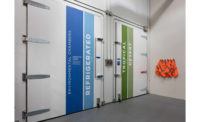Obtaining LEED Certification with Environmentally Friendly Flooring Solutions

Every aspect of a construction site has to be carefully considered to ensure that it complies with the strict green building requirements of the U.S. Green Building  Council (USGBC). This is no less true of the floor, which can account for a significant quantity of the development’s materials, workload, and if not carefully managed, its waste.
Council (USGBC). This is no less true of the floor, which can account for a significant quantity of the development’s materials, workload, and if not carefully managed, its waste.
Advances in sustainable flooring technology mean that developers can specify materials that help the project attain credits for the USGBC’s Leadership in Energy & Environmental Design (LEED) certification program. That’s why a flooring choice is even more relevant to achieving green accreditation than ever before. Case in point: the latest version of LEED (LEED v4) has an increased focus on indoor environmental quality and the impact that several categories of materials, including flooring, have on it. This in turn affects the number of points that can be accrued via the specified floor, as systems that are detrimental to the building’s interior and inhabitants will make it harder to achieve LEED certification.
Toxic substances
A key LEED consideration is the amount of volatile organic compounds (VOCs) that are emitted during the manufacturing, installation and use of the floor. Typically, construction materials produce large quantities of VOCs, which can be harmful to both the occupants of a building and to the environment. To minimize this harm, the USGBC rewards building projects that utilize products with low, or preferably zero, VOCs content.
Specialist resin floor coatings are available to the construction industry that have had VOCs either partially or entirely removed from the manufacturing process, improving indoor air quality by taking these chemicals out of the supply chain.
Other common construction ingredients with negative environmental and health impacts are phthalates and nonyl phenols. Facilities that need a strong and seamless floor able to withstand heavy impacts, abrasions and thermal shock can take advantage of advanced cementitious urethane systems that are free from phthalates. Epoxy flooring solutions that are nonyl phenol free are available and can provide a hard-wearing, scratch-resistant and economical finish that simultaneously improves the working environment by minimizing the prevalence of this potentially harmful compound.
Green building practices
Thinking through an environmentally friendly lens about how a product is formulated, packaged, transported and disposed of is a great way to help a building site meet green standards. To this end, plant developers should look for flooring suppliers that have put in place efficient and streamlined building practices.
One element of this is construction waste management, which means closely monitoring waste streams to ensure as much material is recycled as possible. Some flooring manufacturers will even integrate reclaimed materials and post-industrial scrap into flooring systems to further reduce the amount of waste produced by the construction industry.
Clever use of packaging can help minimize the amount of material taken to a landfill. For example, in 2013-14, Flowcrete Americas, Houston, Texas, sold over 50% of its cementitious urethane systems in reusable UN-certified intermediate bulk containers (IBCs), which saved at least 100,000 plastic bottles (amounting to 27.5 tons of waste) being sent to landfills.
Sourcing flooring materials from local suppliers will further limit a plant’s carbon footprint by cutting down on the unavoidable environmental impact incurred by transporting significant quantities of material across large distances. On this matter, the LEED guide recommends that the supplier should be located within a 500-mile radius.
Life-cycle costs
LEED is not just concerned with the initial construction of a plant, but also assesses the long-term environmental consequences of the site. This is because materials with a long life-cycle and with low-impact maintenance needs will ultimately have the lowest carbon footprint when the decades-long use of the building is taken into account.
Looking over the floor’s life-cycle costs is a useful way to understand how much the floor is going to cost both financially and environmentally over an extended period of time. Durable, long-lasting and reliable flooring systems can minimize both of these costs by avoiding the waste and expenditure of early renovations and frequent repairs.
Despite a higher initial investment, resinous flooring systems have lower long-term costs compared to alternative materials such as vinyl, rubberized terrazzo and high-grade carpeting. The durability of resin floors means that they will often last for a longer period of time without cracking, failing or staining despite exposure to the most intensive, abusive and large-scale industrial environments.
When a resin floor does reach the end of its life, reparation systems can be utilized to restore the surface. If the old floor is concrete, asphalt, tile, metal or wood, resin systems can be applied directly on top of the previous surface. These attributes of resin systems provide refurbished projects with an option that avoids the environmentally wasteful process of taking up the old floor material.
Active management
Being able to prove that environmentally friendly principles have been effectively woven into every stage of a building’s development is vital for achieving LEED credits. However, this requires active management from the manufacture of the chosen assets through the transportation, installation and ultimately the end-of-life stages of these materials.
If successful, this third-party certification can mean a lot more than the plant having a lower carbon footprint. It also means a higher quality environment for employees, long-term economic savings and that the building has an added inherent value that is only going to become more important as green construction requirements develop.
Looking for a reprint of this article?
From high-res PDFs to custom plaques, order your copy today!





